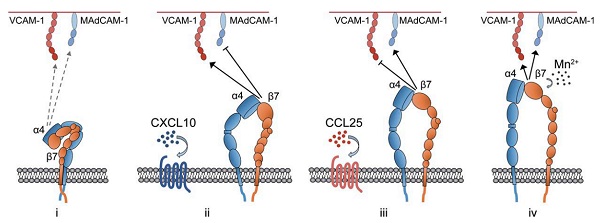Researchers reveal integrin α4β7 switches its ligand specificity via distinct conformer-specific activation
Source:
Time: 2018-05-24
The recruitment of lymphocytes from blood circulation to different tissues is essential for immune surveillance and host defense. During this recruitment process, lymphocytes encounter chemokines on the endothelium of venules, which activate integrins on lymphocytes through the rapid triggering of an ‘inside-out signaling’ network that converts the inactive integrin (in a low-affinity, bent conformation) into its active form, characterised by a high-affinity, extended conformation. The activated integrins then mediate the firm arrest of lymphocytes on the endothelium, a pivotal step during lymphocyte homing. Lymphocyte subsets express unique patterns of integrins and the vascular endothelia in different tissues express the specific ligands. The interaction between integrin and its ligand enables the targeting of lymphocytes to different tissues. However, most integrins expressed on lymphocytes can recognize multiple ligands, theoretically which would hinder lymphocyte trafficking to specific tissues. For example, the primary ligand for integrin a4b7 is MAdCAM-1 that is specifically expressed in the gut. Integrin a4b7 also binds VCAM-1, which is widely expressed on stimulated endothelial cells of blood vessels, peripheral lymph nodes and the bone marrow. In order to maintain the specificity of lymphocyte homing to tissues that express either MAdCAM-1 or VCAM-1, integrin a4b7 needs to distinguish one ligand from the other. Our previous study (Sun H. et al., Dev Cell 2014) has revealed that integrin α4β7 is activated by distinct chemokines (CCL25 and CXCL10) in a ligand-specific manner, thus mediating the selective homing of lymphocytes to different tissues expressing either MAdCAM-1 or VCAM-1. Although the intracellular signaling that induces the ligand-specific activation of integrin α4β7 has been illustrated, how those activated integrins selectively bind to different ligands remains obscure.
Under the guidance of Prof. Jianfeng Chen, Prof. Guohui Li and Prof. X. Frank Zhang, Ph. D student Shuihui Wang et al. has demonstrate that CCL25, CXCL10 and Mn2+ induce three distinct active conformations of integrin α4β7. CCL25 and CXCL10 stimulation stabilizes α4β7 integrins in two different intermediate open conformations, which show opposite affinities for MAdCAM-1 and VCAM-1 by recognizing their immunoglobulin (Ig) domain 2 (D2), resulting in the switch in integrin ligand specificity. Mn2+ induces the fully open conformation of α4β7 with a high affinity for both ligands. Specifically, using atomic force microcopy (AFM)-based single-molecule force spectroscopy (SMFS), we show that CCL25 stimulation of RPMI 8866 cells increases single-molecule affinity of α4β7 for MAdCAM-1 but decreases α4β7 affinity for VCAM-1, whereas CXCL10 has the opposite effect. In contrast, Mn2+-activated α4β7 shows the highest affinity for both ligands. Structurally, integrin intramolecular fluorescence resonance energy transfer (FRET) studies reveal that CCL25 and CXCL10 stimulation induces two intermediate open active conformations of α4β7 on cell membrane, whereas Mn2+ induces a fully open conformation of α4β7. Notably, CCL25-activated α4β7 has a more extended structure than CXCL10-activated integrin. Consistently, computational molecular dynamics (MD) simulation identifies two distinct intermediate open conformers of α4β7 headpiece during its transition from the closed to open conformation, which shows an inverse binding free energy to the same ligand. Although the primary binding site for integrin α4β7 is in Ig domain 1 (D1) of MAdCAM-1 and VCAM-1, a swap of D2 in these two ligands reverses the ligand preference of CCL25- and CXCL10-activated α4β7 integrins, suggesting D2 in MAdCAM-1 and VCAM-1 serves as the identity element distinguished by the two distinct intermediate open conformers of α4β7.
This study entitled “Integrin α4β7 switches its ligand specificity via distinct conformer-specific activation” was published online in The Journal of Cell Biology on May 22, 2018. This work was supported by grants from the National Natural Science Foundation of China, National Basic Research Program of China, American Heart Association, Personalized Medicines-Molecular Signature-based Drug Discovery and Development, the Strategic Priority Research Program of the Chinese Academy of Sciences and the CAS/SAFEA International Partnership Program for Creative Research Teams.

Schematic representation of chemokine- or Mn2+-induced integrin α4β7 conformers with distinct ligand-binding specificity

 Appendix:
Appendix: